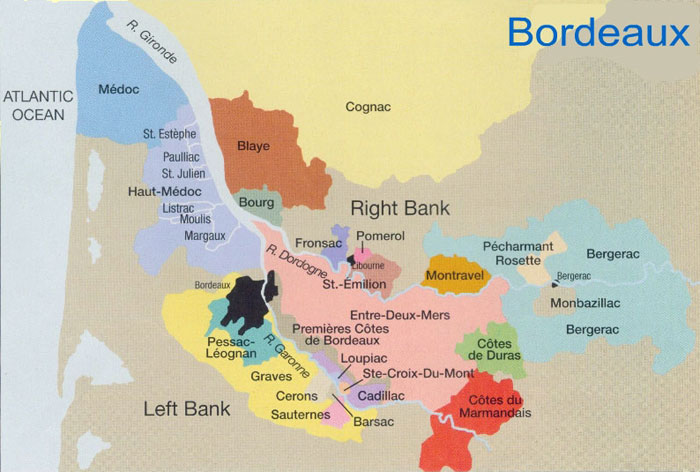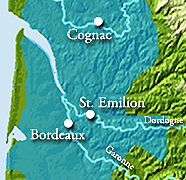Bordeaux One of the most famous cities in France
Located on the west Atlantic coast, the city is marvelous, small and not overwhelming to the visitor. It is a key destination for anyone interested in French culture, lifestyle and wine. With a charming 18th century old town, a fabulous waterfront promenade and a long history, no one ever complains about Bordeaux. Since the 8th century, the area’s wines have been enjoyed around the world. Bordeaux’s prosperity is directly due to the region’s grapes, the wine made from them and shipped around the world from it’s port. Many people travel here to visit the vineyards and learn about the wines, but others come for the architecture, history, culture, water and land sports, museums, education, and the wonderful French cuisine. With is broad avenues, monumental squares, nooks and crannies, and extensive waterfront, the city is a wonderful place to wander around. You can explore the city with your smartphone with the Monument Tracker app (1.5 Euros) launched by the Bordeaux Tourist Information Office. See the city by mini-train, open-topped bus, Segway, or tram or on foot.
Bordeaux Wine
With more than 110,000 hectares of vineyards, 57 appellations, 9,000 wine-producing châteaux, 13,000 grape growers and 400 traders, annual sales of over 14.5 billion euros – wine rules. Over 700 million bottles a year are produced, ranging from inexpensive to some of the most expensive in the world. 90% of Bordeaux wine is red, blended from Merlot, Petit Virdot, Malbec, Cabernet Franc, Cabernet Sauvignon. The reds are drinkable when young but can benefit from aging. The white wines range from sweet (Sauternes), dry, and a small quantity of rosé and sparkling wines (Crémant de Bordeaux). The whites are a surprise and worth looking into! Bordeux does not have a single Wine Trail, it has dozens. The appellations were justified by terroir and micro-climate to help the French consumer. Vineyards can be small family owned, some biodynamic in their cultivation – with hand picked grapes and old style production methods – including concrete vats. Large producers may use mechanical equipment to pick, optical recognition equipment to select grapes with just the right amount of sugar, stainless steel tanks, and temperature controlled barrel aging. The process of vinfication is complex and winemakers love to discuss the details and fine points.
Wine Ideas
1. Tour the vineyards – Pick an appellation and discover it’s vineyards with a wine tour arranged through the tourist office.
2. Go to school – Bordeaux’s Wine Council (CIVB) has a Wine School on their site offering introductory or advanced courses–including oenological weekends, evening classes or intensive courses – for all who share a passion for wine.
3. Visit a wine bar – Le Bar a Vin et l’Ecole du Vin – open to all-comers, go to discover Bordeaux wine diversity. Wines by the glass, local tapas or cheese board to nibble while you enjoy the wine.
4. Dinners with Winemakers, Vintage Days – harvest workshops and tasting classes can be arranged through the Bordeaux Tourist Information Office.
5. New, free, internet application geolocates a chateau you wish to visit, a wine bar or even a historic monument – www.bordeauxwinrtrip.com
Did you know? The 5 first growth châteaux are:
• Château Lafite Rothschild – produces some of the most expensive wines in the world
• Château Margaux – one of their bottles of Château Margaux 1787 was insured for $225,000
• Château Latour – has some very old vines that have been around since the 14th century
• Château Haut-Brion – the only non-medic estate to be included in the 1855 classification
• Château Mouton Rothschild – the latest to join the first growth club in 1973
Take a fun quiz to test your smarts about wine here
Food
Bordeaux is famous for its Arcachon Bay oysters. You can sample with a bottle of the local wine at La Boîte à Huitres on cours du Chapeau Rouge, near the Place de la Bourse. Other outstanding local produce (seasonal) to seek out include Pauillac lamb, white asparagus from Blaye, Aquitaine caviar, cep mushrooms, Bazas beef, shad and lamprey from the river.
Fine French cuisine is recognized by UNESCO as part of world heritage. Bordeaux has 5 Michelin stars in the city and another 8 within an hour’s drive. A new wave of kitchen wizards has radically transformed the gastronomic landscape, updating its vocabulary and menus with contemporary ingredients and cutting edge techniques. Many chefs are willing to pass on their know-how in cooking classes even to tourists! The annual Epicuriales event includes free cooking classes and cocktail workshops. Each evening a different Michelin-starred chef offers a tasting combining fine cuisine and great wine.
History & Architecture
• Old Town
Bordeaux is one of the largest 18th century architectural urban areas in all of Europe. Because of its amazing buildings and level of preservation it is on UNESCO’s World Heritage List.
• Grand Théâtre – built in 1780, is truly beautiful, topped with 12 golden statues
• Cathédrale Saint-André de Bordeaux (Bordeaux Cathedral) – built on the site of a much earlier religious building it was consecrated by Pope Urban II in 1096; Ailenor of Aquataine married here
• Église Sainte-Croix (Church of the Holy Cross) – amazing Romanesque abbey
• Basilica of Saint-Seurin – the oldest church in Bordeaux built in the 6th century
• Place du Parlement – Louis XV style, reminiscent of an Italian piazza, with carved facades and tall windows decorated with macarons
• Grosse Cloche tower, one of the most important monuments in Bordeaux
Markets
• Chartrons market along the waterfront on Sunday mornings for fresh produce and relaxed lunch
• Saint Michel market on Sunday evenings,for second hand clothing, furniture, fabrics, heaps of trinkets, saucepans and modern treasures
• Capucins Market Hall, daytime, Tues-Fri, for oysters and wine and to catch the color and scents
• Quai des Chartrons for organics on Thurs
• Les Grands Hommes indoor market Mon-Sat, greengrocer stalls, shops, cafes and restaurants
• Christmas Market, December, Allees de Tourny
• Quinconces Antiques Fair, three weeks in Nov & Dec, for home décor: furniture, paintings, linen, books, records.
Museums
• Musée des Beaux Arts
• Musée d’Aquitaine
• Musée des Arts Décoratifs
• Musée D’Histoire Naturelle
• CAPC – Museum of Contemporary Art
• Musée National des Doines
• Vinorama
• Musée Goupil
• Cap Sciences is a great science museum
• Centre Jean Moulin
• Base Sous-marine (submarine base)
• Musee National des Douanes (Nat’l Customs Museum)
• Musee du Vin et du Negoce
• Bernard Magrez Cultural Institute. The first Sunday of the month, during the “car free” day, a contemporary art bus drives passangers around the city to explore the latest art venues to raise the visibility of emerging atists. At each venue cultural guide offers commentary and the passengers are welcomed by the artists. Cost 5 Euros.
Music
• There’s a wide choice of entertainment – independent playhouses and café-thatres and of course the Grand Theatre where a repertoire varied from classical ballet, contemporary works, baroque music and shows are aimed at all types of audiences. Bordeaux has a 120 member National Orchestra, 38 dancers in their ballet company and 40 singers in the opera company as well as many guest artists. Bordeaux has since 1962 played a major roll in the French rock music scene. They’ve had garage rock, punk rock, electric rock, stoner rock, indie pop, and after 50 years the rock scene is still going strong –worth discovering. www.bordeauxrock.com
Other Sights and Activities
• Rue Sainte-Catherine is a wonderful pedestrian only shopping street, filled with great shops, restaurants and cafes. This is the longest shopping street in Europe – the shops become more expensive the further one walks towards Place de La Comedie.
• Cours de l’Intendance is where the most high-end and exclusive boutiques and shops are located
• Pont de Pierre – oldest bridge – from here you can walk up the river, past the famous Place de la Bourse, to the Esplanade des Quinconces (one of the largest squares in France)
• Self-guided tours – easy to do with a map from the tourist office. Bordeaux is very walkable and easily navigated on foot. The tourist office is very close to the Quinconces tram stop
• Cinesites: from May – Sept this festival brings movie screens to unexpected locations giving free viewing and an opportunity to discuss the films in a relaxed setting • Car free Sundays – 1st Sun of the month, brings out rollerbladers, cyclists, and pedestrians.
Transportation
The tram – innovative, non-polluting means of transport is the easiest way to get around the city – with three lines making 89 stops. One pass can be used for the tram or the bus – they’re owned by one company. 10% of the residents travel by bike on a daily basis. Tourists can do the same. There are 163 kilometres of cycling trails putting Bordeaux in front of major European cycling cities. 3,500 Vcub self-service bikes are available for public use.
Bordeaux wine (From Wikipedia, the free encyclopedia) here
A Bordeaux wine is any wine produced in the Bordeaux region of France, centered on the city of Bordeaux and covering the whole area of the Gironde department, the largest wine growing area in France. Map below shows most of the appelations. The Garonne and Dordogne rivers, and Gironde estuary help define the region.




















